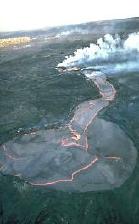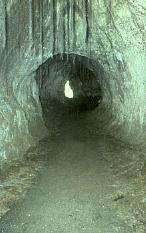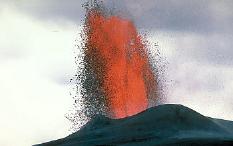Lava
Lakes,Tubes,
and Fountains
Lava
Lakes

Lava lakes form when molten
lava becomes trapped in a volcanic crater or depression. The
term is used to describe lakes that are completely molten,
as well as those that are partially or completely
solidified. Lava lakes can be as deep as 120 m (400 ft), and
can take as long as 30 years to cool and
solidify.
Lava
Tubes

Lava tubes are tunnels
which form when the outer layer of a lava flow cools and
solidifies, but the lava beneath the surface remains fluid
and continues to flow. A large lava flow typically has one
main lava tube plus several smaller tubes which supply lava
to the front of one or more separate flows. Empty lava tubes
commonly have lava stalactites hanging from their roofs, and
a flat floor which develops as lava drains through the tube.
Lava tubes can be as small as about a meter (3 ft) across or
as large as a railway tunnel.
Lava
Fountains

Lava fountains are jets of
lava that spurt into the air from vents, fissures, and from
within active lava lakes. They form when gas bubbles in
molten rock rapidly expand as they reach the surface,
forcing the lava to be erupted high into the air. Most lava
fountains rise to about 10 to 100 meters (30 ft. to 330 ft)
in height, although they occasionally reach even greater
heights. This highest lava fountain ever recorded occurred
in 1986 on the Izu-Oshima volcano in Japan. It reached a
height of 1,600 meters (5,200 ft).
Photo Credits:
E.W. Wolfe, USGS
(top)
Hawaii Volcanoes National Park (middle)
J.D. Griggs, USGS
|
 Photoglossary
Photoglossary Photoglossary
Photoglossary